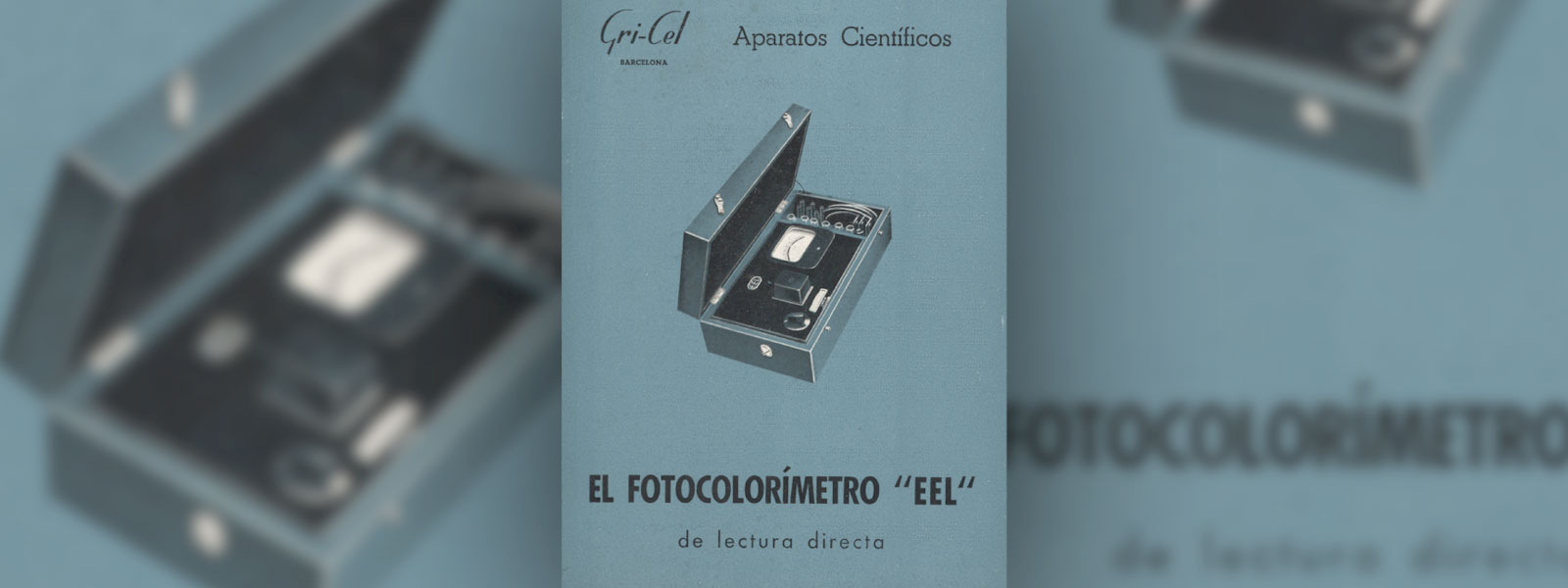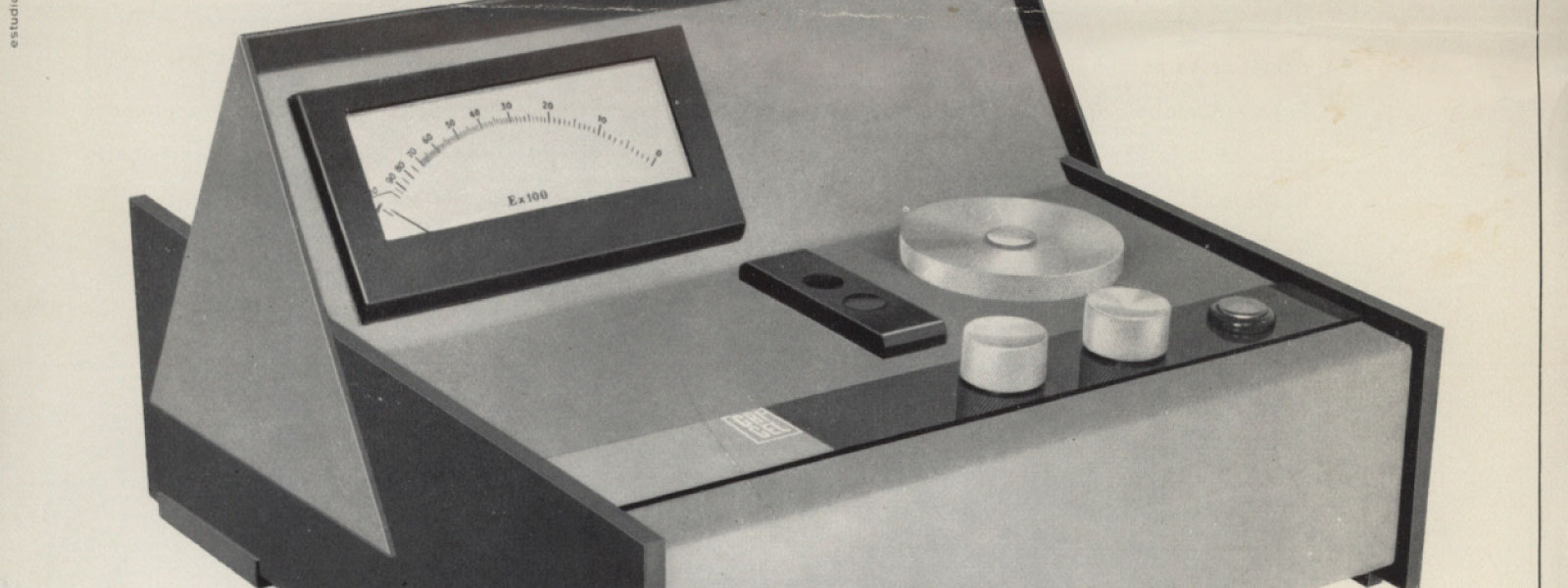Photoelectric colorimeters and spectrophotometers
Harnessing the power of light in the laboratory
Technical file
Type of innovation: Device; System
Scope: Clinical Analysis
Innovation leader: Grifols i Lucas, Víctor
Year: 1970
Period: 1909-1971
Geographical scope: Spain
Economic impact: High
Level of innovation: Adaptive
Patent: No
Interdisciplinary connections: -
In biochemistry, photometry involves accurately measuring the absorption or dispersal of light by a solution. This has a number of potential applications, such as biochemical analysis, the study of enzyme reactions, and protein isolation. Specific applications of spectrophotometry include measuring levels of bilirubin, hemoglobin, and glucose in the blood.
The first photometers
Although the first photometers were developed at the end of the 19th century, it was not until the middle of the 20th century that they became generally available. The first commercially available spectrophotometer was the Beckman DU, a device that used a prism to separate light into different wavelengths and which measured both visible and ultra-violet light. It was introduced in 1941, and was deployed in many projects, including the development of penicillin.
However, such spectrophotometers were relatively expensive. During the 1950s, routine laboratory analysis was performed with photoelectric colorimeters. These consisted of a light source, a series of color filters, a light-sensitive element to convert the light into electric energy, a microammeter to record the energy level, and a variety of methods for interpreting the results.
“Grifols took a major step forward with the manufacture of the Gri-Cel photocolorimeters and spectrophotometers.”
The EEL photocolorimeter:the first Gri-Cel device
The EEL photocolorimeter was the first device to be marketed by Gri-Cel, in 1951. The company had not designed the device itself but rather manufactured and sold it under license from a British firm, Evans Electroselenium Ltd. To give the device the quality finish it deserved, Dr. Víctor Grifols decided that the wooden case should imitate the style of the German microscope cases of the period, with beveled joints, in contrast with the right angles preferred by Spanish cabinet makers at the time, which required simpler machinery and less skill. The device received the case it deserved, although Dr. Grifols' attention to detail meant a significantly lower profit margin.
The EEL used three filters, with further options. A selenium photoelectric cell transformed the light into electrical energy, and this was then read by a microammeter. The results were interpreted using a calibration graph, a chemical calculator, or a logarithm calculator.

The E-4 and the F series photocolorimeters
In 1960, Gri-Cel took a major step forward with the manufacture of its own photocolorimeter, the E-4. This cutting-edge scientific device won the DELTA ADI-FAD Prize in 1962 and featured a case designed by the company's chief publicist, Mr. Baqués. This product line continued to develop, with the release of the E7 in the 1970s and the F2, F5, and F8 in the late 1970s and early 1980s.

Gri-Cel develops its own spectrophotometer
In the early 1960s, Gri-Cel made yet more substantial progress with the manufacture of its own spectrophotometer, the Spectro Spot, a device that had been specially designed to measure the small quantities of light absorbed by a blood sample. In the late 1970s, a new model, the RD50, went into production.
Between 1980 and 1986, Gri-Cel and Dade Grifols also manufactured the RDJ-55. This was a modular automation system for biochemical assays that consisted of four components: the RDJ 55 spectrophotometer, the RDJ printer, the Flow system, and the Calcin-67 processor. Although this was not a Gri-Cel invention (it was produced under license from Helena), Gri-Cel did develop three complementary products that were part of a modular system: a printer, a flow system, and – a first for Grifols – a kinetic calculator that used a micro-computer.
Chronology
| 1666 | Sir Isaac Newton uses the term spectrum to describe the phenomenon of light dispersion. |
| 1800 | John Herschel discovers infra-red radiation. |
| 1801 | Ritter discovers ultra-violet radiation. |
| 1802 | William Hyde Wollaston uses the first spectrometer. |
| 1807 | Thomas Young demonstrates the wave theory of light using the double-slit experiment. |
| 1808 | Étienne-Louis Malus discovers the polarization of light by reflection. |
| 1814 | Joseph von Fraunhofer is the first person to study solar spectrum lines, and embark on the systematic study and measurement of their wavelength. |
| 1817 | Young solves the problem of "polarization by reflection". |
| 1820 | The astronomers John Herschel and William Fox Talbot analyze the color of the flames emitted by various chemical salts, giving birth to the discipline of flame spectroscopy. |
| 1834 | William Fox Talbot distinguishes "strontium red" and "lithium red", the first application of analytical optical spectroscopy. |
| 1859 | Gustav Kirchhoff and Robert Bunsen develop a rigorous experimental protocol for the detailed study of the spectra of chemical compounds, establishing that atomic spectra can be used to identify individual elements, and laying the foundations of analytical spectroscopy. |
| 1887 | Henry A. Rowland revolutionizes experimental spectroscopy with his concave grating. |
| 1925 | G. Scheibe, W. Gerlach and E. Schweitzer perform first quantitative spectral analysis. |
| 1926 | G. Hansen constructs the first double-beam recording spectrophotometer. |
| 1941 | Under the direction of American chemist and inventor, Arnold Orville Beckman, National Technical Laboratories develop and markets the DU spectrophotometer. Key to its commercial success are its ease of use, accuracy, and speed. |
| 1947 | Beckman's team goes on to develop other models and a range of accessories that can be used to modify the DU to perform other tasks. One of the first of these accessories is a flame combined with a photomultiplier, enabling the user to examine the flame of elements such as potassium, sodium and cesium. |
| 1950 | Beckman Industries develops the DR and DK spectrophotometers, double-beam ultraviolet spectrometers with automated recording of results. |
| 1972 | Warren Lee Butler uses a Cary 14 monochromator linked to a microcomputer, thus pioneering optical spectroscopy in biological research. |
Bibliography
Avellà, R., & Miquel, B. (Eds.). (2015). Cuando un sueño se cumple. Crónica ilustrada de 75 años de Grifols. Barcelona: Grupo Grifols, S.A.
Gri-Cel, S.A. [ca. 1960]. Aparatos científicos. [Sales brochure]. Barcelona: Gri-Cel, S.A.
Gri-Cel, S.A. (1962). Aparatos científicos. [Sales brochure]. Barcelona: Gri-Cel, S.A., y Grupo American Hospital Supply Corporation.
Gri-Cel, S.A. (1962). Fotocolorímetro modelo E-4. [Sales brochure]. Barcelona: Gri-Cel, S.A.
Gri-Cel, S.A. [ca. 1980]. Spectrophotometer RDJ-55. [Sales brochure]. Barcelona: Gri-Cel, S.A.
Dade Grifols, S.A. [ca. 1980]. Sistema RDJ Gri-Cel. [Sales brochure]. Barcelona: Dade Grifols, S.A.
Dade Grifols S.A. [ca. 1980]. Procesador RDJ Calcin-67 Gri-Cel. [Sales brochure]. Barcelona: Dade Grifols, S.A.
Schmidt, W. (2005). Optical Spectroscopy in Chemistry and Life Sciences. WILEY-VCH Verlag GmbH & Co. KGaA, Weinheim ISBN 3-527-29911-4
Grifols, S.A. (2001). Dedicado a la vida... Barcelona: Probitas Pharma, S.A.
Related innovations
DEVICE
Microtiter plate readers
